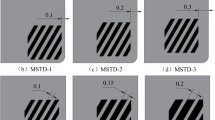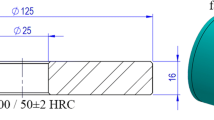Abstract
Interrupted hard turning performance of ceramic tools with varying microscopic geometries on the rake face was analyzed. A new performance index Gma was proposed for the ceramic tools. Both the external loads and the micromechanical properties of the tool material were incorporated in the proposed tool performance index. Quantitative analysis was conducted to reveal the two-dimensional fluid-like characteristics of the chip. Different kinds of microscopic textures such as MA, MB, MC, and MD were created on the rake face for ceramic tools considering the analysis results. Based on the tool performance index, performance of ceramic cutting tools which had varying microscopic textures were pre-evaluated for different groups of cutting speeds and cutting length ratios. Experimental tool lives were acquired to demonstrate the tool performance index and identify the optimum tool surface microscopic geometry. It was found that the tool performance index can be utilized to effectively pre-evaluate tool performance. Microscopic textures MB, MC, and MD were more efficient for tool life extension at relatively small cutting length ratio and relatively large cutting speed. Due to the consideration of the two-dimensional fluid-like characteristics of the chip in the design process, microscopic texture MD exhibited the highest efficiency in the tool performance enhancement.

























Similar content being viewed by others
References
Zhao J, Yuan X, Zhou Y (2010) Cutting performance and failure mechanisms of an Al2O3/WC/TiC micro-nano-composite ceramic tool. Int J Refract Met Hard Mater 28(3):330–337
Jiang Z, Sun J, Xiong Q, Wang L, Li J (2017) Structural design of groove and micro-blade of the end mill in aluminum alloys machining based on bionics. Int J Adv Manuf Technol 88(9–12):3343–3356
Deng J, Wu Z, Lian Y, Qi T, Cheng J (2012) Performance of carbide tools with textured rake-face filled with solid lubricants in dry cutting processes. Int J Refract Met Hard Mater 30(1):164–172
Koshy P, Tovey J (2011) Performance of electrical discharge textured cutting tools. CIRP Ann Manuf Technol 60(1):153–156
Xie J, Luo M, He J, Liu X, Tan T (2012) Micro-grinding of micro-groove array on tool rake surface for dry cutting of titanium alloy. Int J Precis Eng Manuf 13(10):1845–1852
Feng Y, Zhang J, Wang L, Zhang W, Tian Y, Kong X (2017) Fabrication techniques and cutting performance of micro-textured self-lubricating ceramic cutting tools by insitu forming of Al2O3–TiC. Int J Refract Met Hard Mater 68:121–129
Kümmel J, Braun D, Gibmeier J, Schneider J, Greiner C, Schulze V, Wanner A (2015) Study on micro texturing of uncoated cemented carbide cutting tools for wear improvement and built-up edge stabilization. J Mater Process 215:62–70
Wu Z, Deng J, Su C, Luo C, Xia D (2014) Performance of the micro-texture self-lubricating and pulsating heat pipe self-cooling tools in dry cutting process. Int J Refract Met Hard Mater 45:238–248
Enomoto T, Sugihara T, Yukinaga S, Hirose K, Satake U (2012) Highly wear-resistant cutting tools with textured surfaces in steel cutting. CIRP Ann Manuf Technol 61(1):571–574
Sugihara T, Enomoto T (2013) Crater and flank wear resistance of cutting tools having micro textured surfaces. Precis Eng 37(4):888–896
Kazban RV, Mason JJ (2007) Fluid mechanics approach to machining at high speeds: part I: justification of potential flow models. Mach Sci Technol 11(4):475–489
Kazban RV, Mason JJ (2007) Fluid mechanics approach to machining at high speeds: part II: a potential flow model. Mach Sci Technol 11(4):491–514
Kwon KB, Cho DW, Lee SJ, Chu CN (1999) A fluid dynamic analysis model of the ultra-precision cutting mechanism. CIRP Ann Manuf Technol 48(1):43–46
Ramesh A, Melkote SN (2008) Modeling of white layer formation under thermally dominant conditions in orthogonal machining of hardened AISI 52100 steel. Int J Mach Tool Manu 48(3–4):402–414
Lemaitre J, Desmorat R (2005) Engeering damage mechanics: ductile, creep, fatigue and brittle failures. Springer, Berlin
Wang D, Zhao J, Zhao J, Li A, Chen X (2014) Microstructure-level modeling and simulation of the flexural behavior of ceramic tool materials. Comput Mater Sci 83:434–442
Ashby MF, Hallam SD (1986) The failure of brittle solids containing small cracks under compressive stress states. Acta Mater 34(3):497–510
Li HB, Zhao J, Li TJ (2000) Micromechanical modelling of the mechanical properties of a granite under dynamic uniaxial compressive loads. Int J Rock Mech Min Sci 37(6):923–935
Horii H, Nemat-Nasser S (1986) Brittle failure in compression: splitting, faulting, and brittle-ductile transition. Phil Trans R Soc A 319(1549):337–374
Kemeny JM (1991) A model for non-linear rock deformation under compression due to sub-critical growth. Int J Rock Mech Min Sci Geomech Abstr 28(6):459–467
Cui X, Zhao J, Zhou Y, Zheng G (2013) Damage mechanics analysis of failure mechanisms for ceramic cutting tools in intermittent turning. Eur J Mech A/Solid 37:139–149
Ravichandran G, Chen W (1991) Dynamic failure of brittle materials under uniaxial compression. Am Soc Mech Eng Appl Mech Div AMD 130:85–90
Ravichandran G, Subhash G (1995) A micromechanical model for high strain rate behavior of ceramics. Int J Solids Struct 32(17–18):2627–2646
Nemat-Nasser S, Obata M (1988) A microcrack model of dilatancy in brittle materials. J Appl Mech 55(1):24–35
Pekelharing AJ (1978) The exit failure in interrupted cutting. Ann CIRP 27:5–10
Malkin AY, Isayev AI (2006) Rheology: concepts, methods, and applications. ChemTec Publishing, Toronto
Tong J, Sun J, Chen D, Zhang S (2005) Geometrical features and wettability of dung beetles and potential biomimetic engineering applications in tillage implements. Soil Tillage Res 80:1–2): 1–12
Bixler GD, Bhushan B (2013) Fluid drag reduction with shark-skin riblet inspired microstructured surfaces. Adv Funct Mater 23(36):4507–4528
Ding Y, Yang L, Cheng B, Wang X, Wang Y, Xie H (2018) Investigations on femtosecond laser-modified microgroove-textured cemented carbide YT15 turning tool with promotion in cutting performance. Int J Adv Manuf Technol 96(9–12):4367–4379
Li Q, Yang S, Zhang Y, Zhou Y, Cui J (2018) Evaluation of the machinability of titanium alloy using a micro-textured ball end milling cutter. Int J Adv Manuf Technol 98(5–8):2083–2092
Acknowledgments
This project is sponsored by the National Natural Science Foundation of China (Grant No. 51505132), the Fundamental Research Funds for the Universities of Henan Province (Grant No. NSFRF170304), and the Science Research Funds for the Universities of Henan Province (Grant No. J2018-3).
Author information
Authors and Affiliations
Corresponding author
Additional information
Publisher’s note
Springer Nature remains neutral with regard to jurisdictional claims in published maps and institutional affiliations.
Rights and permissions
About this article
Cite this article
Cui, X., Guo, J. Interrupted hard turning performance of ceramic cutting tools possessing microscopic geometries established with the two-dimensional fluid-like characteristics of the chip considered. Int J Adv Manuf Technol 103, 3575–3595 (2019). https://doi.org/10.1007/s00170-019-03770-7
Received:
Accepted:
Published:
Issue Date:
DOI: https://doi.org/10.1007/s00170-019-03770-7




